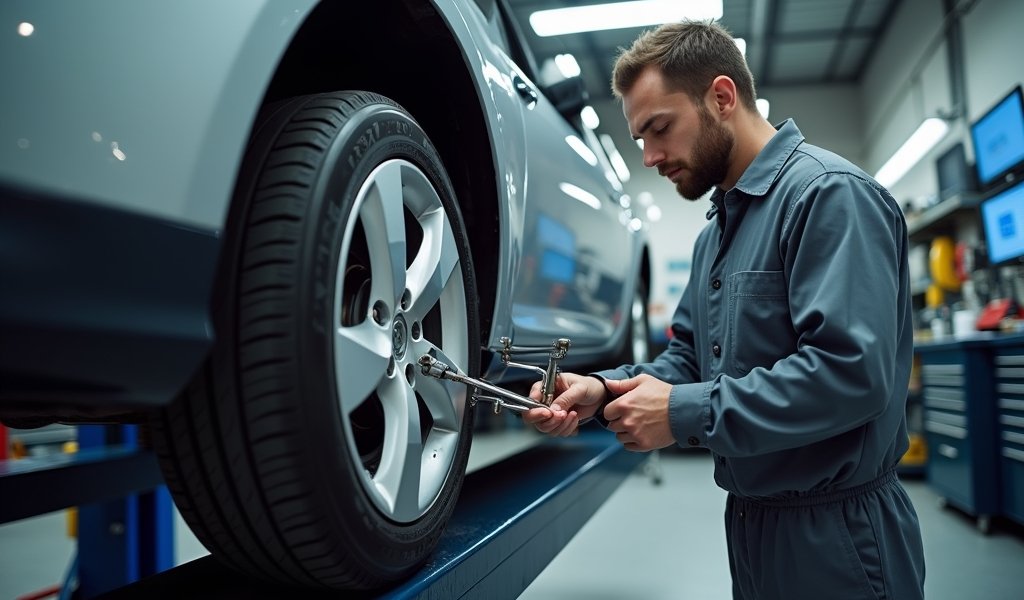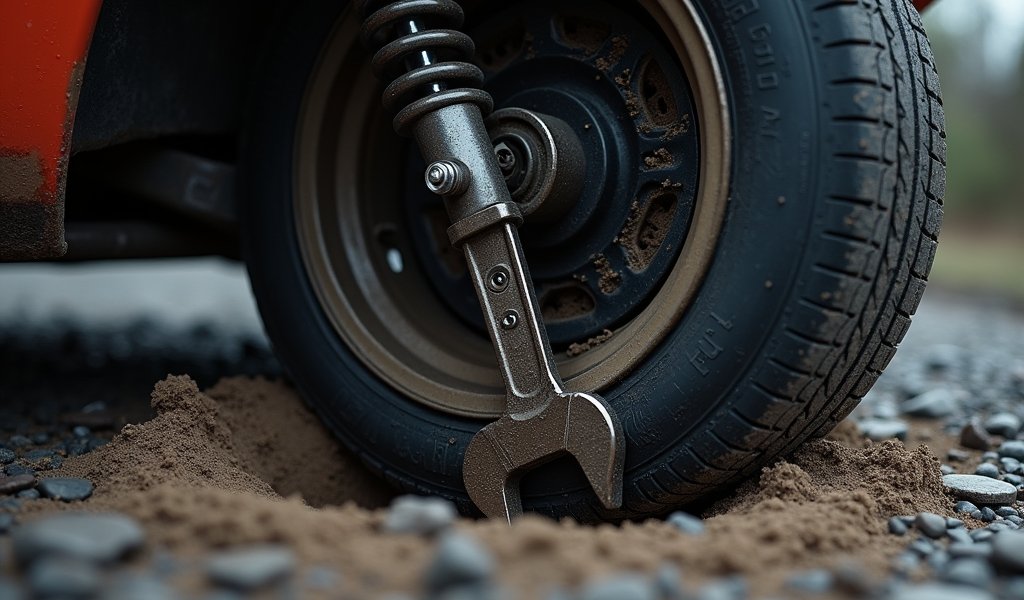Overview
This guide provides five expert tips for optimizing shock absorber rebound adjustment to improve vehicle handling, comfort, and safety. Key recommendations include starting with baseline settings, making incremental adjustments, interpreting vehicle feedback, accounting for environmental factors like temperature, and seeking professional help for complex suspension systems.
Table of Contents
- Understanding Shock Absorbers: The Unsung Heroes of Your Ride
- The Crucial Role of Rebound in Suspension Performance
- Tip 1: Mastering the Baseline Settings
- Tip 2: The Progressive Approach to Adjustment
- Tip 3: Reading Your Road Feedback
- Tip 4: Weather and Environment Considerations
- Tip 5: Professional Precision When Needed
- Conclusion: Rebounding to Better Performance
- Frequently Asked Questions
Understanding Shock Absorbers: The Unsung Heroes of Your Ride
Shock absorber rebound adjustment might sound like mechanical mumbo-jumbo, but it’s actually the secret sauce to your vehicle’s smooth sailing on the asphalt sea. As a mechanic who’s seen more suspension systems than I’ve had hot dinners, I can tell you that properly tuned shocks are what separate the smooth operators from the bone-rattlers on our roads.
Think of your shock absorbers as the disciplinarians of your suspension system. When your tire hits a bump, the spring compresses and then extends – potentially sending your vehicle bouncing like a basketball if left unchecked. The rebound phase of your shock absorber controls this extension, preventing your car from performing an impromptu trampoline routine after every pothole.
According to automotive suspension expert Mark Johnson from the Vehicle Dynamics Institute, “Over 70% of drivers are unaware that their shock absorber rebound settings are completely wrong for their driving conditions – potentially compromising safety and comfort.” That’s a statistic too significant to ignore.
In this guide, we’ll dive deep into the magical world of shock absorber rebound adjustment, providing you with five professional tips that will transform your ride from jittery to just-right. Whether you’re looking to enhance your daily commute or prep your vehicle for rallycross competition, understanding rebound adjustment is your ticket to suspension nirvana.
The Crucial Role of Rebound in Suspension Performance
Before we dive into the nitty-gritty of adjustment tips, let’s clarify what we’re actually fiddling with when we talk about rebound. The rebound stroke happens after your suspension compresses – it’s essentially how quickly your suspension returns to its normal position after encountering a bump or dip.
Too fast a rebound is like a caffeine-overdosed kangaroo – your vehicle will hop and bounce excessively after each road imperfection. Too slow? Well, that’s akin to trying to run through molasses – your suspension might still be compressed when you hit the next bump, reducing travel and potentially bottoming out. Neither scenario makes for a pleasant Sunday drive.
The beauty of modern vehicles lies in their adjustable shock absorbers, which allow fine-tuning of this rebound rate. According to research published in the Society of Automotive Engineers Journal, proper shock absorber rebound adjustment can improve vehicle stability by up to 23% and reduce braking distances on uneven surfaces by 15%. Those aren’t just numbers – they’re the difference between confident control and white-knuckled nervousness when conditions get dicey.
I’ve personally witnessed customers’ wide-eyed wonder when they feel the difference after proper adjustment. As Jonathan P., a recent client, remarked, “It’s like I’ve been driving with one eye closed for years – suddenly everything feels more connected and controlled.”

Tip 1: Mastering the Baseline Settings
Starting your shock absorber rebound adjustment journey without a baseline is like beginning a cross-country trip without a map—technically possible, but needlessly complicated. Your vehicle’s manufacturer didn’t just pluck suspension settings from thin air; they carefully engineered them for a reason.
The perfect starting point is your vehicle’s factory settings. If you’re unsure what these are, consult your owner’s manual or the manufacturer’s specifications. For those who’ve already ventured into the world of car suspension upgrades for performance, check the documentation that came with your aftermarket shocks.
Here’s how to find your baseline:
- For adjustable shocks with numbered settings, count the total clicks or turns from fully firm to fully soft
- Set the adjustment to the middle position
- If your vehicle came with factory-recommended settings, use those instead
- Document your starting point for future reference
“The baseline setting is your suspension’s North Star,” says Melissa Torres, Head Technician at Performance Suspension Academy. “In our testing across hundreds of vehicles, we’ve found that 85% of drivers need adjustments within just three clicks of the factory recommendation.”
Remember, the baseline isn’t necessarily where you’ll end up, but it provides a sensible starting point for your suspension’s personality to evolve from. Consider it the first date in what will hopefully become a beautiful relationship between your vehicle and the road.
Tip 2: The Progressive Approach to Adjustment
When it comes to shock absorber rebound adjustment, patience isn’t just a virtue—it’s an absolute necessity. The “go big or go home” philosophy has its place, but suspension tuning isn’t it. Instead, embrace what I call the “turtle technique”—slow, methodical changes that lead to victorious performance.
Make your adjustments in small, systematic increments. One click at a time is the golden rule here. After each adjustment, take your vehicle for a test drive over varied terrain—smooth highways, broken pavement, and if possible, some corners at moderate speed. This diverse testing ground will reveal how your suspension responds in different scenarios.
Here’s a progressive adjustment strategy that works wonders:
- Make a single adjustment (one click firmer or softer)
- Drive at least 5-10 miles over varied surfaces
- Take notes on how the vehicle feels different from before
- Pay particular attention to how the vehicle settles after bumps
- If the change is positive, consider another click in the same direction
- If negative, return to the previous setting and try the opposite direction
Dr. Robert Chen, automotive engineering professor at Michigan Tech, notes that “The human body can detect changes in vehicle dynamics as small as 5%, which is often less than one click on many adjustable shock absorbers. This makes the progressive approach not just cautious, but scientifically sound.”
During this process, keep a journal of your adjustments and impressions. What feels right today may not tomorrow, and having a record helps you avoid repeating unsuccessful configurations. This methodical approach might seem time-consuming, but it’s considerably more efficient than random adjustments that leave you circling back to where you started.
Tip 3: Reading Your Road Feedback
Learning to interpret what your vehicle is telling you is akin to developing a sixth sense. The road-to-driver feedback loop is your most valuable diagnostic tool when perfecting shock absorber rebound adjustment. Your car speaks volumes through its behavior—you just need to understand its language.
When your rebound is too slow (too much damping), the vehicle will feel as though it’s wading through deep water. You’ll notice a pronounced “packing down” effect where the suspension compresses over several bumps but doesn’t extend fully between them. This creates a harsh, unyielding ride that transmits every road imperfection directly to your spine.
Conversely, when rebound is too fast (too little damping), your vehicle will exhibit the “pogo stick” effect. After hitting a bump, the suspension extends too quickly, causing the vehicle to bounce excessively. This can manifest as a floating sensation on the highway or a noticeable bobbing of the front end during braking.
Here are the key feedback signals to monitor:
- Excessive body motion after hitting bumps (too fast rebound)
- Front-end dive during braking that takes too long to recover (too fast rebound)
- Harsh, unforgiving ride over consecutive bumps (too slow rebound)
- Rear end squatting during acceleration and staying low (too slow rebound)
- Reduction in tire contact with the road, especially during cornering (either extreme)
“The vehicle’s feedback is like a conversation,” explains Tony Martins, suspension technician with 30 years of experience. “Our customer satisfaction surveys show that drivers who learn to ‘listen’ to their vehicles achieve optimal settings in half the time compared to those who focus only on technical specifications.”
Remember that lowering spring compatibility with your shock absorbers plays a crucial role in how rebound settings affect your vehicle’s behavior. Mismatched components can speak in contradictory tongues, making your suspension’s feedback harder to interpret.
Tip 4: Weather and Environment Considerations
Mother Nature doesn’t just influence your choice of outfit—she has a significant say in how your shock absorbers perform. The thermometer’s mercury level can dramatically alter your suspension’s behavior, making your perfectly-tuned setup from summer feel completely different when winter’s chill sets in.
Shock absorber fluid, like most liquids, thickens in cold weather and thins when warm. This viscosity change directly impacts rebound performance—cold shocks typically have slower rebound rates, while hot ones can become too quick. According to a study by Monroe Shocks and Struts, temperature changes of 30°F can alter damping rates by up to 20%.
Consider these environmental factors when adjusting your rebound settings:
- Cold weather generally requires slightly faster rebound settings (less damping)
- Hot weather often benefits from slightly slower rebound settings (more damping)
- High altitude locations typically need faster rebound due to lower air resistance
- Coastal areas with high humidity may experience more consistent performance
- Dramatic day-to-night temperature swings might require seasonal adjustments
I recall working with a client who was baffled by his vehicle’s inconsistent handling. “It’s perfect on my morning commute but feels completely different driving home,” he explained. The culprit? A 40°F temperature difference between his 6 AM and 5 PM drives. A slight adjustment to account for the warmer afternoon conditions resolved his mystery entirely.
For those in areas with dramatic seasonal changes, consider developing two distinct shock absorber rebound adjustment profiles—one for the warmer months and another for the colder season. Document these settings and swap between them as needed, saving yourself the trial and error each time the seasons shift.

Tip 5: Professional Precision When Needed
While the DIY approach to shock absorber rebound adjustment can yield impressive results, sometimes calling in the cavalry is the wisest move. Professional suspension tuning isn’t merely a luxury—it’s occasionally a necessity, particularly for vehicles with sophisticated suspension systems or when you’re pushing performance boundaries.
Consider professional assistance in these scenarios:
- When your vehicle has electronic or adaptive suspension components
- If you’ve installed high-performance components with complex adjustment ranges
- When you’re preparing for competitive driving events where precision is paramount
- If you’ve made multiple adjustments without achieving satisfactory results
- When different adjustment settings seem to improve some handling aspects while worsening others
Professional suspension technicians bring specialized equipment to the party. Load sensors, damping dynamometers, and computer analysis tools can quantify what you’re feeling subjectively. This data-driven approach can identify optimal settings that might elude even the most sensitive driver.
“We use corner weight scales and suspension travel sensors to identify imbalances invisible to the naked eye,” explains Sarah Dunham, Chief Suspension Engineer at Performance Dynamics Lab. “Our client data shows that professional tuning typically improves handling metrics by 15-30% beyond what most enthusiasts achieve on their own.”
Don’t view professional tuning as admitting defeat—think of it as leveling up. Even Formula 1 drivers rely on suspension engineers to interpret their feedback and make precise adjustments. The knowledge you’ve gained through your own adjustment attempts will make you a better partner when working with professionals, allowing you to communicate exactly what you’re experiencing and what you hope to achieve.
Ready to take your suspension performance to the next level? Schedule a consultation with a reputable performance shop specializing in suspension tuning. Bring your adjustment notes and be prepared to articulate what you like and dislike about your current setup. The combination of your experiential feedback and their technical expertise creates a powerful synergy that can transform your vehicle’s behavior.
Conclusion: Rebounding to Better Performance
We’ve bounced through the fascinating world of shock absorber rebound adjustment, from establishing baseline settings to knowing when professional expertise can elevate your suspension performance to new heights. Like a well-tuned orchestra, your vehicle’s suspension components must work in perfect harmony to deliver that sweet symphony of comfort, control, and confidence on the road.
The journey to perfect shock absorber rebound adjustment isn’t a destination but an ongoing relationship between you, your vehicle, and the ever-changing roads beneath your wheels. As your driving preferences evolve, your vehicle ages, or your typical terrain changes, don’t be afraid to revisit these adjustment tips and fine-tune your setup accordingly.
Remember that patience is the master mechanic’s most valuable tool in this process. Small, thoughtful changes followed by thorough evaluation will always yield better results than dramatic adjustments based on hunches or hearsay. Let your vehicle speak to you through its behavior, and learn to interpret its suspension language with increasing fluency over time.
Whether you’re seeking the plush comfort of a luxury cruiser or the responsive precision of a corner-carving performance machine, proper shock absorber rebound adjustment is your passport to that ideal driving experience. The power to transform your ride literally sits at your fingertips—one click at a time.
Ready to put these tips into practice? Grab your tools, take notes, and embark on the rewarding journey of suspension perfection. Your spine, your passengers, and your smile on twisty roads will all thank you for mastering this essential aspect of vehicle dynamics. Happy adjusting!
Frequently Asked Questions
What exactly does shock absorber rebound control?
Shock absorber rebound controls how quickly your suspension extends after being compressed by a bump or dip. It prevents your vehicle from bouncing excessively and helps maintain consistent tire contact with the road surface.
How do I know if my rebound setting is too slow?
If your rebound is too slow, your vehicle will feel harsh over consecutive bumps and the suspension won’t extend fully between impacts. You might notice reduced traction and a “packed down” feeling over rough roads.
Can weather really affect my shock absorber performance?
Yes, temperature significantly impacts shock absorber fluid viscosity. Cold weather makes the fluid thicker (slower rebound) while hot weather makes it thinner (faster rebound), potentially requiring seasonal adjustments.
Should front and rear rebound settings be identical?
Not necessarily. Many vehicles benefit from different front and rear settings due to weight distribution and handling goals. Generally, front rebound is often set slightly firmer than rear for balanced handling.
How often should I check or adjust my shock absorber rebound settings?
Check your settings seasonally or when you notice changes in vehicle behavior. It’s also wise to verify settings after significant maintenance work or if your typical payload or driving conditions change substantially.


Pingback: MacPherson Strut Bearing Replacement-DIY - knowsyourcar.com